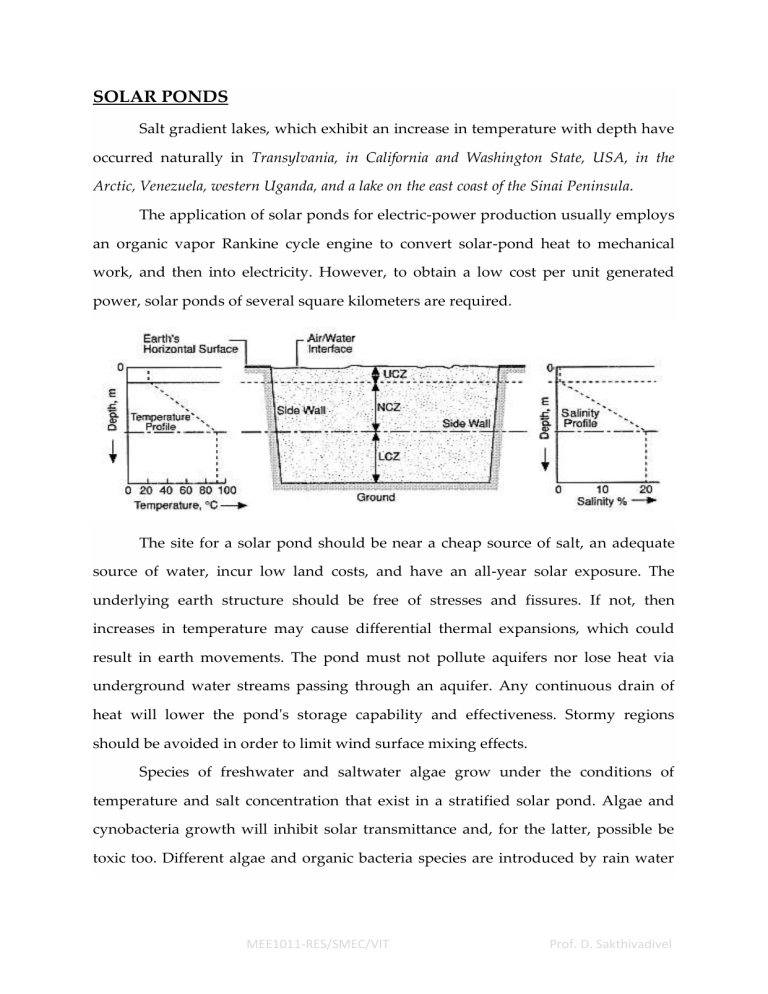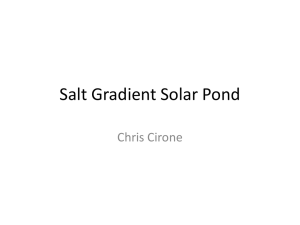
SOLAR PONDS Salt gradient lakes, which exhibit an increase in temperature with depth have occurred naturally in Transylvania, in California and Washington State, USA, in the Arctic, Venezuela, western Uganda, and a lake on the east coast of the Sinai Peninsula. The application of solar ponds for electric-power production usually employs an organic vapor Rankine cycle engine to convert solar-pond heat to mechanical work, and then into electricity. However, to obtain a low cost per unit generated power, solar ponds of several square kilometers are required. The site for a solar pond should be near a cheap source of salt, an adequate source of water, incur low land costs, and have an all-year solar exposure. The underlying earth structure should be free of stresses and fissures. If not, then increases in temperature may cause differential thermal expansions, which could result in earth movements. The pond must not pollute aquifers nor lose heat via underground water streams passing through an aquifer. Any continuous drain of heat will lower the pond's storage capability and effectiveness. Stormy regions should be avoided in order to limit wind surface mixing effects. Species of freshwater and saltwater algae grow under the conditions of temperature and salt concentration that exist in a stratified solar pond. Algae and cynobacteria growth will inhibit solar transmittance and, for the latter, possible be toxic too. Different algae and organic bacteria species are introduced by rain water MEE1011-RES/SMEC/VIT Prof. D. Sakthivadivel and airborne dust. To prevent algae formation, copper sulfate, has been added at a concentration of about 1.5 mg l−1. A solar pond will cease to function without maintenance of the vertical salt gradient stratification. The stability of the salt gradient is maintained by: 1. controlling the overall salinity difference between the two converting layers, 2. inhibiting internal convection currents if they tend to form in the NCZ, 3. limiting the growth of the UCZ. Salt slowly diffuses upwards at an annual average rate of about 20 kg m −2 as a result of its concentration gradient. This rate varies and is dependent upon the ambient environment conditions, type of salt and temperature gradient. Surface washing by fresh water and injecting brines of adequate density at the bottom of the pond usually maintain an almost stationary gradient. UCZ growth caused by surface flushing is diminished if the velocity of the surface washing water is small. Surface temperature fluctuations will result in heat being transferred upwards through the UCZ by convection, especially at night, and downward, more slowly, by conduction. The thickness of the UCZ also varies with the intensify of the incident insolation. The higher the temperature of the UCZ, and the lower the humidity above the pond's surface, the greater will be the evaporation rate caused by insolation and wind action. Excessive evaporation results in a downward growth of the UCZ. Evaporation can be compensated by surface water washing, as well as reduce the temperature of the pond's surface especially during periods of high insolation. Windbreaks will reduce evaporation rates. Though evaporation can be the dominant mechanism in surface-layer mixing under light-to-moderate winds, it is minor under strong winds. MEE1011-RES/SMEC/VIT Prof. D. Sakthivadivel

